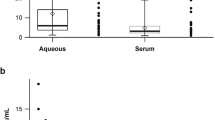Abstract
Purpose
We examined the predictive factors for final visual acuity (VA) with macular edema of branch retinal vein occlusion (BRVO) treated by intravitreal injection of bevacizumab (IVB) and examined the differences between patients without recurrent macular edema due to BRVO after a single IVB and patients treated with multiple IVB because of recurrent macular edema.
Methods
In this retrospective study, 37 eyes of 37 patients with BRVO were treated with IVB and followed up for more than 24 weeks. Eighteen eyes showed no recurrence of macular edema after a single IVB (single IVB group). The remaining 19 eyes showed recurrent macular edema and underwent multiple IVB (multiple IVB group). VA and morphologic parameters of optical coherence tomography were examined.
Results
Mean VA, central retinal thickness, and mean retinal thickness in a circular region of 1-mm diameter at the fovea improved significantly with IVB treatment in both groups. Final VA was correlated with baseline VA and integrity grade of the photoreceptor inner and outer segment (IS/OS) line beneath the fovea.
Conclusion
Baseline VA and IS/OS line grade at 4 weeks may be predictive factors for final VA.




Similar content being viewed by others
References
Kumagai K, Furukawa M, Ogino N, Uemura A, Larson E. Long-term outcomes of vitrectomy with or without arteriovenous sheathotomy in branch retinal vein occlusion. Retina. 2007;27:49–54.
The Branch Vein Occlusion Study Group. Argon laser photocoagulation for macular edema in branch vein occlusion. Am J Ophthalmol. 1984;98:271–82.
Parodi M, DI Stefano G, Ravalico G. Grid laser treatment for exudative retinal detachment secondary to ischemic branch retinal vein occlusion. Retina. 2008;28:97–102.
Jaissle G, Leitritz M, Gelisken F, Ziemssen F, Bartz-Schmidt KU, Szurman P. One-year results after intravitreal bevacizumab therapy for macular edema secondary to branch retinal vein occlusion. Graefes Arch Clin Exp Ophthalmol. 2009;247:27–33.
Kondo M, Kondo N, Ito Y, Kachi S, Kikuchi M, Yasuma TR, et al. Intravitreal injection of bevacizumab for macular edema secondary to branch retinal vein occlusion. Retina. 2009;29:1242–8.
Kreutzer TC, Alge CS, Wolf AH, Kook D, Burger J, Strauss R, et al. Intravitreal bevacizumab for the treatment of macular oedema secondary to branch retinal vein occlusion. Br J Ophthalmol. 2008;92:351–5.
Rabena MD, Pieramici DJ, Castellarin AA, Nasir MA, Avery RL. Intravitreal bevacizumab (Avastin) in the treatment of macular edema secondary to branch retinal vein occlusion. Retina. 2007;27:419–25.
Hoeh AE, Ach T, Schaal KB, Scheuerle AF, Dithmar S. Long-term follow-up of OCT-guided bevacizumab treatment of macular edema due to retinal vein occlusion. Graefes Arch Clin Exp Ophthalmol. 2009;247:1635–41.
Ach T, Hoeh AE, Schaal KB, Scheuerle AF, Dithmar S. Predictive factors for changes in macular edema in intravitreal bevacizumab therapy of retinal vein occlusion. Graefes Arch Clin Exp Ophthalmol. 2010;248:155–9.
Hoeh AE, Ruppenstein M, Ach T, Dithmar S. OCT patterns of macular edema and response to bevacizumab therapy in retinal vein occlusion. Graefes Arch Clin Exp Ophthalmol. 2010;248:1567–72.
Chung EJ, Hong YT, Lee SC, Kwon OW, Koh HJ. Prognostic factors for visual outcome after intravitreal bevacizumab for macular edema due to branch retinal vein occlusion. Graefes Arch Clin Exp Ophthalmol. 2008;246:1241–8.
Mitamura Y, Hirano K, Baba T, Yamamoto S. Correlation of visual recovery with presence of photoreceptor inner/outer segment junction in optical coherence images after epiretinal membrane surgery. Br J Ophthalmol. 2008;93:171–5.
Noma H, Funatsu H, Yamasaki M, Tsukamoto H, Mimura T, Sone T, et al. Pathogenesis of macular edema with branch retinal vein occlusion and intraocular levels of vascular endothelial growth factor and interleukin-6. Am J Ophthalmol. 2005;140:256–61.
Sakamoto A, Tsujikawa A, Ota M, Yamaike N, Kotera Y, Miyamoto K, et al. Evaluation of potential visual acuity in eyes with macular oedema secondary to retinal vein occlusion. Clin Exp Ophthalmol. 2009;37:208–16.
Kriechbaum K, Prager F, Geitzenauer W, Benesch T, Schütze C, Simader C, et al. Association of retinal sensitivity and morphology during antiangiogenic treatment of retinal vein occlusion over one year. Ophthalmology. 2009;116:2415–21.
Author information
Authors and Affiliations
Corresponding author
About this article
Cite this article
Yunoki, T., Miyakoshi, A., Nakamura, T. et al. Treatment of macular edema due to branch retinal vein occlusion with single or multiple intravitreal injections of bevacizumab. Jpn J Ophthalmol 56, 159–164 (2012). https://doi.org/10.1007/s10384-011-0114-3
Received:
Accepted:
Published:
Issue Date:
DOI: https://doi.org/10.1007/s10384-011-0114-3




